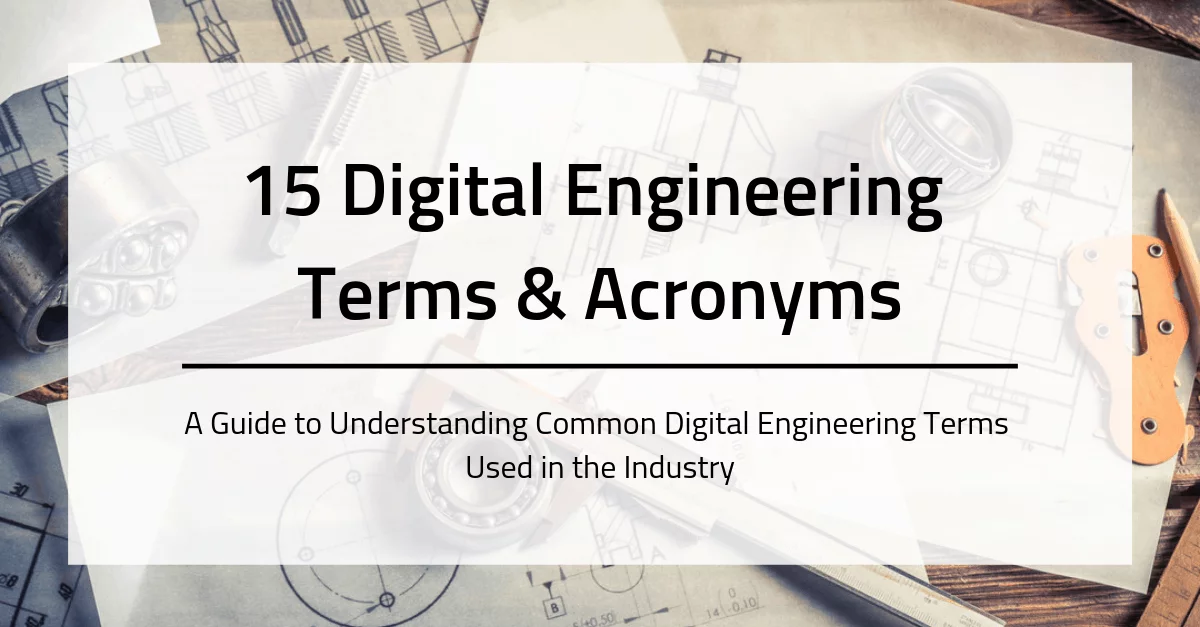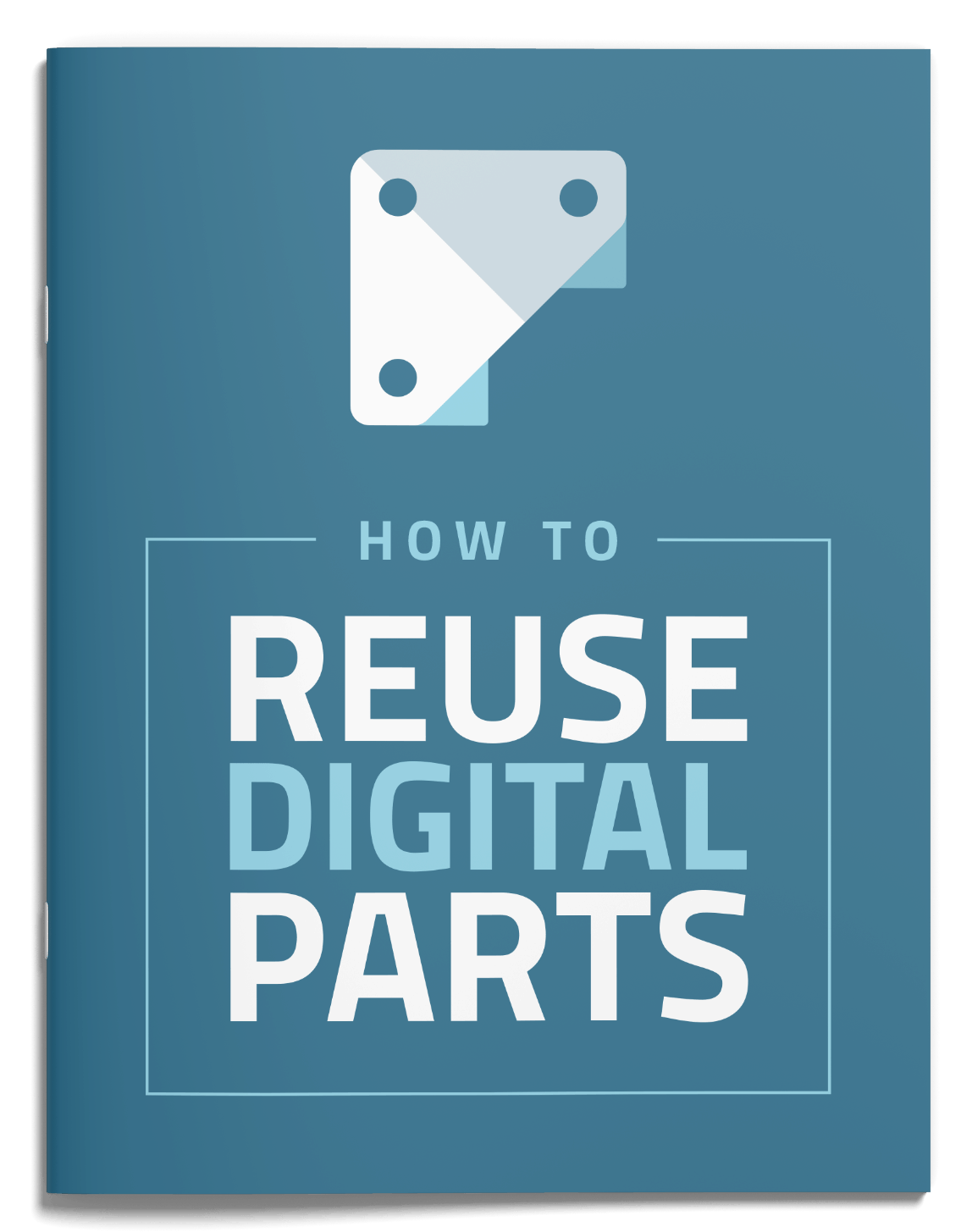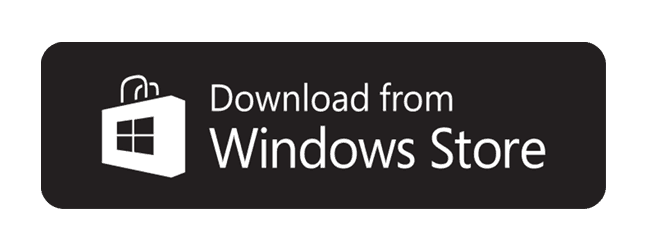15 Valuable Digital Engineering Terms & Acronyms All Teammates Need to Know
The language can get complicated. The solution shouldn’t be. Here’s a guide to understanding common digital engineering terms used in the industry.
You sit down with a multi-disciplinary team to discuss your strategy to improve the velocity of your product development and the ways you can gain new market share.
How do you get on the same page when you have engineers, IT professionals, marketing, business executives, and SME (subject matter experts) speaking different languages?
Honestly, sometimes you don’t or you can’t. So that leads me to ask how do we add clarity to the conversation?
We simplify and create a space for transparency where the so-called “dumb questions” can be asked.
My goal in this post is to create a list of terms or acronyms that apply to the digital engineering landscape so that teams can find a common ground for sharing their vision of the future together.
If you have any items you would like to see on this list, please add a comment with your term and a source for a definition so I can add it to our conversation.
Know the digital engineering terms? Now it’s time to put them to practice: Learn the building blocks of a successful parts management strategy.
Digital Engineering Terms
1.Digital Twin:
Definition(s): “A digital twin (Siemens) is a virtual representation of a physical product or process, used to understand and predict the physical counterpart’s performance characteristics. Digital twins (IBM) are used throughout the product life-cycle to simulate, predict, and optimize the product and production system before investing in physical prototypes and assets.”
My take: The goal of this term in the industry, in my opinion, is to push the boundary of technology to match what we see in real life. How closely can we define things in real life in a virtual environment so that companies can reduce the cost of product development?
2. MBE: Model-Based Enterprise:
Definition(s): “Model Based Enterprise (MBE) is a company-wide initiative to augment 3D models with additional information to create new documentation deliverable’s beyond engineering.” — Lifecycle Insights
“Model-based enterprise (MBE) is an engineering strategy that aims to clarify design intent during the manufacturing process by using a 3D model-based definition (MBD) that includes all the product and manufacturing information (PMI) associated with manufacturing the product. The goal of MBE is to improve efficiency, produce better quality products and reduce costs.” — TechTarget
My take: I like to think of “MBE” as a game of “telephone” where the message you are sending is the instructions to build something complicated. Additionally, I see the shift toward MBE approaches as a way to make that message simpler.
3. MBD- Model Based Definition
Definition(s): “In MBD, the 3D product model is the sole carrier of comprehensive information, intended to eliminate the need for 2D drawings. The MBD dataset fundamentally consists of a 3D solid model with all geometry features as well as 3D annotations of required tolerances and manufacturing instructions, to specify a complete product definition.” — DesignNews
My take: MBD is an aspiration to simplify the communication process of complex technical information and remove a legacy step from the process as well. All major CAD vendors support these efforts but there still needs to be open communication between OEM’s and those vendors to improve on MBD functionality further.
4. TDP- Technical Data Package
Definition(s): “TDP is the complete documented set of technical information, data, software, and drawings that describe the system to the level necessary to manufacture, implement, test, and maintain a project initiative” — OOI (Ocean Observatories Initiative)
My take: A technical data package has become a necessity for communicating requirements and all relevant info to a supplier or an outside party. Thankfully, improvements to technology have made it easier to assemble this information. However, there is a lot to communicate and there still seems to be areas for improvement with technical data packages. For example, I think TDP’s represent a great use case for applying block-chain technology in the exchange process.
5. PMI – Product Manufacturing Information
Definition(s): “PMI is Product Manufacturing Information. In ASME Y14.41 language this means the annotations and attributes contained in a 3D solid model that complement the geometric definition and complete the digital data set. PMI is a critical data component of a 3D solid model that enables Model-Based Engineering (MBE).” — Action Engineering
“Companies are increasingly transitioning to 3D model-based environments as a means for communicating downstream manufacturing requirements i.e. adding Product and manufacturing information (PMI) such as geometric dimensions and tolerances, annotations directly within the 3D model. In such an environment, 3D models serve as a master data, depicting design intent more effectively to downstream users in manufacturing, assembly and inspection processes.” — ECN Mag
My take: I think PMI is critical for improving the speed and efficiency of downstream processes that directly relate to a part’s geometry. There are several examples in which this is a huge time saver such as inspection when an operator creates an inspection program for a CMM (coordinate measurement machine). That quality information is important to close the loop between supplier and OEM. As important as I think PMI is on the model, I do think there are some gaps in how effective it can be to some downstream processes — for example when a manufacturing process still has variability based on equipment in use (I am thinking of sheet metal and forming via straight breaks in this case).
6. ECR/ECO/ECN: Engineering Change Request/Order/Notice
Definition(s): “An engineering change order (ECO) is a documentation packet that outlines the proposed change, lists the product or part(s) that would be affected and requests review and approval from the individuals who would be impacted or charged with implementing the change. ECOs are used to make modifications to components, assemblies, associated documentation and other types of product information.” — Arena Solutions
My take: The engineering change process needs to be well documented so that anyone who looks at product data can see the story behind why things were changed and the impact of those changes. This is critical to have a well-defined process especially as a company grows.
7. MBSE – Model-Based Systems Engineering
Definition(s): Model-Based Systems Engineering (MBSE) is the practice of developing a set of related system models that help define, design, and document a system under development. These models provide an efficient way to explore, update, and communicate system aspects to stakeholders, while significantly reducing or eliminating dependence on traditional documents.” — © Scaled Agile, Inc.
A second resource.
My take: I see MBD falling under this category. The difference is that MBSE is a more overarching view beyond the details you need to manufacture something. This approach to design can be applied to software, electrical, and mechanical product design.
8. PLM- Product Lifecycle Management
Definition(s): “A strategic business approach that applies a consistent set of business solutions in support of the collaborative creation, management, dissemination, and use of product definition information across the extended enterprise, and spanning from product concept to end of life—integrating people, processes, business systems, and information.” — CIMdata
“Problematic and Likely to Malfunction” is another connotation with PLM. — Urban Dictionary
My take: You can’t do business today if you are designing and producing a product without a system that enables your business to track changes and history to your design process. That system must also allow for better collaboration.
My friend, @JamieHowe has put together a great presentation called PLM 101 that gives you a great overview of PLM as a concept.
Common terms I hear to summarize PLM: “Cradle to grave”, “Single source of truth”, “platform for innovation”, “authoritative source”
9. PDM- Product Data Management
Definition(s): “The use of software or other tools to track and control data related to a particular product. The data tracked usually involves the technical specifications of the product, specifications for manufacture and development, and the types of materials that will be required to produce the good. The use of product data management allows a company to track the various costs associated with the creation and launch of a product. Product data management is part of product life cycle management, and is primarily used by engineers.”
My take: PDM is a subset of PLM and is typically limited in functionality. However, its core functionality is to establish a “vault” of core documents (3D models, 2D drawings, and other associated files) and allow the user to track revisions to those documents.
10. Digital Thread
Definition(s): “At its most fundamental level, the digital thread is a re-imagined version of the manufacturing value chain —one powered by data and advanced analytical power, and optimized for the digital age. Each stage of the digital thread is, itself, comprised of and enabled by an integrated ecosystem of digital technologies that work in concert to tackle a particular challenge in the production process.” –Deloitte
The digital thread refers to the communication framework that allows a connected data flow and integrated view of the asset’s data throughout its lifecycle across traditionally siloed functional perspectives. The digital thread concept raises the bar for delivering “the right information to the right place at the right time.” — IndustryWeek
My take: This term is very overarching, similar to the Industry 4.0 trend. It encompasses a lot of steps in the process. I see PLM systems and associated add-on’s creating this digital thread for companies. I do not see how a company can achieve this vision with only one vendor or system for every scenario.
11. COTS- Commercial-Off-the Shelf (COTS) parts
Definition(s): “Miriam-Webster defines Off-the-Shelf as something that’s “available as a stock item: not specially designed or custom-made”; and COTS is defined as an “item that is commercially available, leased, licensed, or sold to the general public and which requires no special modification or maintenance over its life cycle.” There are many products out there that are commercially available, there’s no argument there, but what’s difficult in today’s business world is finding the right commercially available off-the-shelf part for a specific design.”
My take: There are challenges and risks (NASA) associated with introducing parts designed by external suppliers. It is important to have the right screening process in place, so I would advocate enterprises put some thought into a gated process for introducing new parts into their ecosystem in order to mitigate any risks. Some companies I work with have introduced a Commercial Part Request (CPR) process to ensure they have the right information about a model they know makes a great part before they introduce it into their PLM environment.

12. SPM- Stategic Parts Management
Definition(s): Strategic Parts Management is the practice of considering the application, standardization, technology (new and aging), system reliability, maintainability, supportability and cost in selecting parts and addressing availability, logistics support and legacy issues in supporting them throughout the life of the systems.
My take: How you onboard new parts into your engineering part database is important to consider. The potential for increased costs in product development can be huge if things go unchecked. The gatekeeper in the past is often the CAD librarian, the problem with this approach is that the end user does not see the whole picture and still continue to add extra cost to product design and makes the life of the CAD librarian difficult.
13. Digitalization – creating a digital copy and workflow of a physical
Definition(s): “Digitalization is the use of digital technologies to change a business model and provide new revenue and value-producing opportunities,” according to Gartner’s glossary. “It is the process of moving to a digital business.” — Forbes
My take: I see digitalization as the process of moving from analog or legacy processes to accomplish a task to a more agile or digital-centric approach (think “going paper-less”). This bleeds into other concepts like the Digital Twin and Digital Thread as well.
14. Digitization – One example is to scan a paper document into a digital asset like a PDF.
Definition(s): “is the process of changing from analog to digital form”
My take: This term is often confused with digitalization.
15. CoE: Center of excellence
Definition(s): “The definition of a CoE states that they are a group of people leading the organization and its different structures in a specific focus area towards pre-determined goals. Hence, the aim of a CoE is to improve expertise in a certain area and make the most of its resources to help the business to improve. — Cleverism.com
“CoE’s provide a focal point for knowledge management, with the overall goal being the ability to capture new knowledge and practices from inside and outside of the business.”
“CoE is responsible for all aspects of PLM (implementation, on-going operations, development, testing, data migration, training)”–CIMDATA
My take: There is no “Easy” button when it comes to implementing enterprise software, especially when it comes to software that has entanglements with other business systems like PLM or ERP platforms. Depending on the size of a company, it makes sense to task a group within a company to be experts at implementing new processes that are technology driven in an effort to ensure a good ROI (return on investment).
Next Steps: Get engaged, add CLARITY
My goal in laying out the terms above isn’t to add to the acronym soup of our day-to-day work lives. My aim is to educate and clarify what sometimes can be confusing terms as I interact with customers and partners. These are items that I hear sometimes daily in my work conversations, and I want to add as much clarity to the conversation as possible.
With clarity and transparency in mind, I invite you to add a comment below of an acronym that you think needs more clarity in how it is used. Please add a reference source if possible, and I will gladly continue the conversation with you.
This article was also published on LinkedIn.
Learn More: Get These Free eBooks
<a href="https://go.partsolutions.com/Engineer-Smarter-Parts-Management-101">Parts Mgmt. 101</a>
The Basics of SPM
<a href="https://go.partsolutions.com/partsolutions-parts-management-201-ebook">Parts Mgmt. 201</a>
SPM vs. Classification
<a href="https://go.partsolutions.com/parts-management-301-mbe-mbd-for-manufacturers">Parts Mgmt. 301</a>
MBE / MBD for Mfgs
Andrew Hood
Latest posts by Andrew Hood (see all)
- 15 Valuable Digital Engineering Terms & Acronyms All Teammates Need to Know - February 19, 2019
- Disrupt Yourself to Stay in the Game: What That Looks Like in Engineering and Manufacturing in 2019 - January 14, 2019
- 4 Takeaways from 3D CIC – How Organizations Achieve Enterprise Accountability through MBE - October 25, 2018




